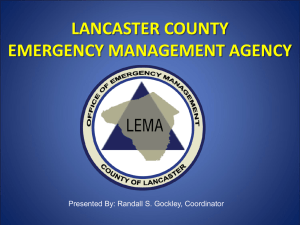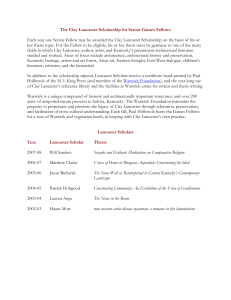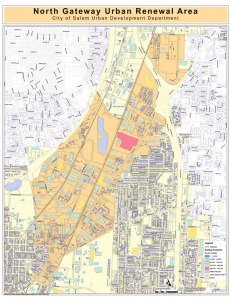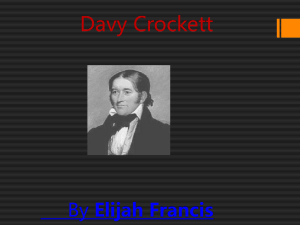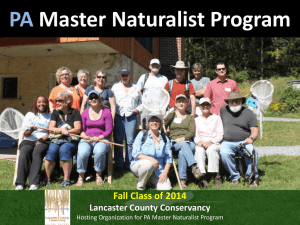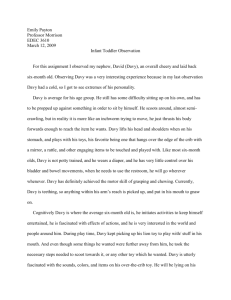HISTFEST 2012 - Lancaster University
advertisement
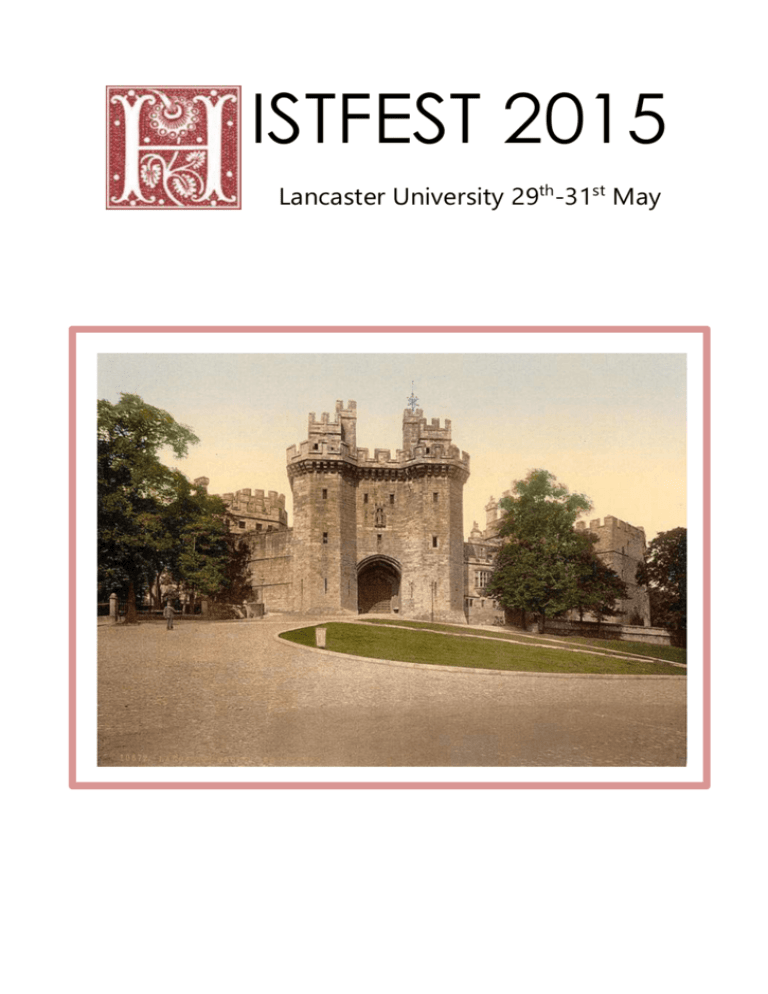
ISTFEST 2015 Lancaster University 29th-31st May Programme of Events Department of History, Lancaster University Day One - Friday 29 May 13:00 – 14:00 Registration (Charles Carter Building Foyer) 14:00 – 14:15 Welcome by Professor Andrew Jotischky, Head of Department 14:15 – 15:45 Session One (George Fox Lecture Theatre 1) Panel One: Technologies of History Chair: Connor Wilson James Perry (Lancaster University) Immigration Patterns in Nineteenth Century England Alex Mankoo, (University College London) Teargas - we haven't got the foggiest: Deconstructing the Ambiguities of Creeping Legitimisation Vanessa Longden (Lancaster University) ‘When you are the camera and the camera is you’: Tracing Techno-Feminism through the Woman Photographer 15:45 – 16:15 16:15 – 17:30 Break Keynote Address Introduction: Vanessa Longden -1- ‘Historical Understanding’ Professor Ludmilla Jordanova, Durham University 17:30 – 18:30 Wine Reception (Ruskin Library) Introduction by Professor Stephen Wildman, Director of the Ruskin Research Centre 19:30 Conference Meal at Nice Bar & Restaurant ****** Day Two – Saturday 30 May 9:00 – 9:30 Coffee (Charles Carter Building) 9:30 – 11:00 Session Two (Charles Carter Building, A15) Panel Two: Expressions Chair: Philip Booth Sarah Ann Robin (Lancaster University) Jewels of the Flesh: The Corporeal Relationship between Jewellery and the Body in the Early-Modern Period Olivia Havercroft, (The University of Manchester) Trickery, tactics and everyday life in the post-war library Kate Bailey (Lancaster University) ‘You Have To Go To The Streets’: The Evocation of Memory through Street Art in Guatemala and Argentina 11:00 - 11:30 Break -2- 11:30 – 12:30 Session Three Panel Three: Contested Spaces and Places Chair: Sarah Ann Robin Jacob Ward (University College London) Relocating Research, Contesting Space: The Post Office Research Station 1958-1975 William Walker (University of Central Lancashire) “Not Waiting for Pugin?” A defence of the early Commissioners’ Churches built under the Church Building Act of 1818 12:30 – 13:30 Lunch 13:30 – 15:00 Session Four Panel Four: Transition & Turning Points Chair: Adrienne Wallman Matthew Pawelski (Lancaster University) “Women”, “Lads” and “Workmen”: Gender, Household, Labour and the Derbyshire Lead Industry Mike Pilkington (Sheffield Hallam University) ‘Fu Manchu’ and the British Empire, 1931 – 1937 Kelly Maddox (Lancaster University) ‘As for those who fail to understand…we have no other alternative than to exterminate them': Resistance and the Emergence of ‘Genocidal Moments’ in Japanese Imperialism, 1937-1945 -3- 15:00 – 16:30 Session Five Panel Five: Rhetoric & Reason Chair: James Perry Martin Walker (Lancaster University) “Reason is such a box of quicksilver that it abides nowhere; it dwells in no settled mansion”: The differing conceptions of “Right Reason” in mid- to late Seventeenth Century England Hervin Fernández-Aceves (University of Leeds) Michael Mann’s theory for the study of Italo-Norman Nobility Connor Wilson (Lancaster University) ‘Et reuera scias quia hoc bellum carnale non est sed spirituale’: Battle Rhetoric in the Gesta Francorum et aliorum Hierosolimitanorum 17:00 Informal Historical Tour of Lancaster ****** Day Three – Sunday 31 May 9:00 – 9:30 Coffee (Charles Carter Building) 9.30 – 11:00 Session Six (Charles Carter Building, A15) Panel Six: Processes of Power Chair: Matthew Pawelski John Aspinwall (Lancaster University) “Drink of the lute chords and the songs of Ma‘bad, no living is serene, save in the sweet heights of Sicily in a dynasty that rivals the empires of the Caesars” – The Historia Sicula and the Medieval Kingdom of Sicily -4- Daniel Feather (Liverpool John Moores University) Britain, South Africa, and soft power diplomacy: initial findings Lynsey Wood (Lancaster University) ‘The very next blood of the King’: the Law of Female Dynastic Succession in English History 11:00 – 11:30 Break 11:30 – 13:00 Session Seven Panel Seven: Social Order Chair: Martin Walker Hattie Lloyd (University College London) Science Lectures in the Press: Davy's Audience at the Royal Institution 1801-1812 Carrie de Silva (Harper Adams University) The Agricultural Educational Provision for Women in England to 1939 Pushpa Kumbhat (University of Leeds) Independent working class education (IWCE) – a 'sub-culture' of the British Labour movement building socialism in Yorkshire 1918 – 1939 13:00 – 14:00 Lunch 14:00 – 15:15 Keynote Address Introduction: Vanessa Longden History meets Biology: Human Experience as a History of the Species Dr Claudia Stein, (University of Warwick) 15:30 Conference Closes -5- ****** John Aspinwall (Lancaster University) j.aspinwall@lancaster.ac.uk “Drink of the lute chords and the songs of Ma‘bad, no living is serene, save in the sweet heights of Sicily in a dynasty that rivals the empires of the Caesars” – The Historia Sicula and the Medieval Kingdom of Sicily Retrospectively interpreting the Norman Conquest of Sicily the anonymously written Historia Sicula, likely composed between June 1146 and July 1148, remains one of only two extant sources that specifically chronicle the conquest of the island from the Muslims. As such, the broad basis of the Historia’s sources act as an important check and balance upon the traditional conquest narrative. However, the Historia further stands as the only surviving chronicle written during the reign of King Roger II and, therefore, the Historia is uniquely important in evidencing a formative period in the history of the Norman Kingdom and indeed the Medieval Mediterranean. Here, the Historia constitutes a window of unsurpassed importance upon state formation in the South Italian Kingdom and intersects the critical junction that had witnessed the embryonic monarchy seek to establish a political settlement that was not only perpetually threatened by hostile foreign influence, but further bedevilled by complex processes of antagonism and acculturation acting upon its ‘Trinacian’ population of Western Europeans, Greek Christians and Muslims. Nevertheless, despite the Historia’s suggested importance, nineteenth century accusations that the Historia was little more than ‘a paltry excerpt... written in barbarous Latin’ from that of Geoffrey Malaterra’s De Rebus Gestis has ensured its virtual anonymity to modern scholarship. The Historia, therefore, still remains a rich and underexploited asset – the utilisation may shake the bedrock of South Italian historiography and throw new light upon a seminal period in the history of the Medieval Mediterranean. Kate Bailey (Lancaster University) k.bailey1@lancaster.ac.uk ‘You Have To Go To The Streets’: The Evocation of Memory through Street Art in Guatemala and Argentina ‘The collective unconscious dwells in the streets, in the public space...So if you want to really address a lot of people or society, you have to go to the streets.’ The streets are a place of power; as the previous quotation from Daniel Hernandez-Salazar suggests, they are a space in which the public become united, and where expressed thoughts and ideas can influence a great number of people. This paper will be examining the art that has been created and installed on the streets and in the public spaces of Guatemala and Argentina, in response to the recent periods of violence that have been inflicted on both countries. It will explore several examples of street art: Hernandez-Salazar’s ‘Street Angels’; Traverso’s bicycle silhouettes; and Galindo’s ‘¿Quien Puede Borrar Las Huellas?’ (Who Can Erase The Footprints?), questioning how the pieces took shape, what the artists’ motivations were, and the impact that this street art had, in order to examine how effective street art is as a political tool for evoking memory within Guatemala and Argentina. -6- Daniel Feather (Liverpool John Moores University) D.J.Feather@2012ljmu.ac.uk Britain, South Africa and soft power diplomacy: Initial findings This paper will analyse the various debates surrounding Britain’s relationship with South Africa from 1958 to 1994. There are three different aspects to this paper; the first theme will be an analysis of the current debates on the formulation of soft power diplomacy, what it is, its strengths and its weaknesses. The next strand will assess Britain’s soft power apparatus and how it has been deployed throughout the world. The final part of this paper will analyse the existing literature on the relationship between Britain and South Africa in the years 1958 to 1994. It will be explained that despite the fact Britain and South Africa still had a persistent and close relationship in the years of apartheid very little scholarly attention has been given to this association. What little has been written about this topic has largely focused on the political and economic relations between these two countries. Despite the breakdown of political relations in this period Britain remained very active in South Africa’s cultural sector. Indeed Britain began to seek a more prominent role in this area from 1958 with the appointment of a cultural attaché to the High Commission in Pretoria. It will be explained how the British policy towards South Africa in this period can be used as a fascinating case study to analyse British cultural diplomacy in a former imperial possession. Hervin Fernández-Aceves (University of Leeds) ms11@hfa@leeds.ac.uk Michael Mann’s theory for the study of Italo-Norman Nobility Sociologist Michael Mann has presented an extensive theoretical and historical account of the history of power in human history in his four-volume work on the sources of social power. In this corpus, Mann offers a historical sociology based upon a systematic insistence on the contingency and conjunctural character of history. As a sociologist who is not prisoner to a single methodology or a single avenue of approach to these supremely complex social processes, Mann attempts to trace causal mechanisms and sequences to show how various social structures and circumstances led to specific kinds of changes in the social order. This approach can be summed up in two premises that can be applied for the study of pre-modern political organisations: 1) societies are constituted of multiple overlapping and intersecting socio-spatial networks of power, and 2) a general account of societies, their structure, and their history can best be given, independently of the existence of a fixed institutional framework, in terms of the interrelations of sources of power: ideological, economic, military, and political relationships. A new frameworks is hence suggested in order to study social power: the "IEMP model:" ideological, economic, military, and political. Mann proposed that these aspects of social reality are largely independent sets of institutions and processes, and they create different though complementary sources of power for individuals and groups within a given state of society. If now I apply these concepts to the medieval aristocracy of the Norman Mezzogiorno, I will be able to identify relevant social aspects despite the fragmentary and pre-modern image that the available sources provide: the social identity and function of the count, the noble baron, the justiciar, and the constable emerge within a system of military, land-holding, honorific and political interactions. -7- Olivia Havercroft (The University of Manchester) olivia.havercroft@postgrad.manchester.ac.uk Trickery, tactics and everyday life in the post-war library In 1959, Joe Orton and his boyfriend Kenneth Halliwell began stealing books from Islington Library. Through the act of collage, Orton and Halliwell transformed the books in often explicit, sometimes respectful, and usually humorous ways. They then replaced the books on the shelves and observed the reactions of the library users. In 1962 they were arrested and sentenced to six months in prison. This unlawful act has been characterized as a moment of notable cultural importance; a queer, working-class rebellion against the post-war library. Historian Richard Hornsey wrote that it subverted ‘interwoven assumptions about knowledge, truth and heterosexuality’ by exposing the reader to ‘queer reading practises’. Hornsey’s work aligns with a wider body of historiography that engages critically with Michel Foucault’s theories to craft non-linear and spatial reworkings of historiographical arguments pertaining to sexuality. This paper seeks to challenge these perceptions and recast the crime as an act of mild cultural elitism rather than a systematic destabilisation of the library space. To do so, I undertake close and contextual analysis of the book covers, analyse the incentive behind the crime and the reactions of the library staff and users, and review the fluctuating ideologies of the library in the 20 th century. Using Michel de Certeau’s theory of everyday life, this paper also argues for consideration of the agency of people within historical spaces and the legacy events acquire in order to understand the significance of moments in the past. Pushpa Kumbhat (University of Leeds) hy12cpk@leeds.ac.uk Independent working class education (IWCE) – a 'sub-culture' of the British Labour movement building socialism in Yorkshire 1918 – 1939 The British IWCE phenomenon was an integral part of the labour movement led and organised by working class people. Primary providers of IWCE were the Workers’ Educational Association (WEA) and the National Council of Labour Colleges (NCLC). Each organisation founded itself on the principle that the working class had a fundamental right to access adult education. The WEA supported the classical liberal education of Oxbridge believing that it would enable working class people to participate as well informed citizens in public life. In contrast, the NCLC rejected Oxbridge education and all State assistance believing that the only way to raise class-consciousness was to disseminate Marxist ideology through adult education. Despite their differences the WEA and NCLC co-existed promoting socialist principles albeit contrarily through education to working class students and, were supported by institutions such as the Trade Union Congress (TUC) and the Parliamentary Labour Party (PLP). I hypothesise that the inter-war IWCE network formed a ‘sub-culture’ of British life offering working class adults an alternative social, economic and political outlook that was not based in traditional conservatism. It exposed students, directly or indirectly, to a different way of living based on socialist ideology and, transformed a small but important minority of working class people enabling them to participate in public life at a municipal as well as national level. In this respect IWCE could be -8- perceived as a catalyst stimulating social change. My paper will present evidence of how IWCE in Yorkshire between the Wars achieved this. Hattie Lloyd (University College London) harriet.lloyd.12@ucl.ac.uk Science Lectures in the Press: Davy's Audience at the Royal Institution 1801-1812 Humphry Davy (1778-1829) lectured at the Royal Institution in London from 1801-1812. He gave lectures on chemistry, but also on geology and agriculture. Davy’s lectures at the Royal Institution became newsworthy items, and were widely reported in the contemporary newspaper and magazine press. In this paper I will argue that accounts of Davy’s lectures in the press have yet to be fully utilised. Few complete accounts of Davy’s lecture courses are known to exist, few of Davy’s lecture notes survive, yet The Observer, Caledonian Mercury and the Morning Chronicle newspapers all committed to publishing weekly accounts of Davy’s lecture courses in 1811 and 1812. Thus far, analysis of the newspaper reports of Davy’s lectures has yielded some surprising evidence; for example that Davy was promoting sodium and potassium as weapons of war, that the Royal Institution becoming a membership organisation in 1810 led to more newspaper reports of Davy’s lectures, and that over half of Davy’s audience was female. Journalists and editors would not have given every word that Davy said equal importance, they selected their highlights: Davy’s focus on natural theology and his use of patriotic rhetoric in both his chemical and geological lectures were quoted in most newspaper articles. Newspapers obtained these accounts of Davy’s lectures from correspondents in Davy’s audience. Members of Davy’s audience thus played a role in controlling the dissemination of scientific ideas to the reading publics of the early-nineteenth century. Vanessa Longden (Lancaster University) v.longden1@lancaster.ac.uk ‘When you are the camera and the camera is you’: Tracing Techno-Feminism through the Woman Photographer It’s hard to tell where you leave off and the camera begins’ reads the 1976 advertisement for the Minolta 35mm SLR. Here, the machine is deemed a natural extension of its owner. The previous year, advertisers of the Polaroid SX-70 stated the machine won’t let you stop looking, ‘The SX-70 becomes like a part of you, as it slips through life effortlessly...’ These cameras, like the Kodak Brownie and later, Polaroid’s New Instant Movies, were primarily marketed at the American suburban housewife. The machine offered convenience while the advertisement created desire. The camera was easy to use, so easy that even a child could do it. All she had to do was point the camera, click the shutter, and relive the moment. While the machine challenged people’s perspectives of the world and of one another, it was first portrayed as preservative tool and only later as an instrument of self-expression. Referring to the works of Haraway, Butler, Kristeva and Irigaray, I argue that the camera enables us to trace the fluidity of the body through lived experience while the photograph itself provides a space where women’s self-articulation can occur. Yet the boundaries between body and machine become increasingly blurred. How can we theorise the fleshiness or materiality of lived bodies and of bodily capabilities when they become increasingly hybridised with the machine? My aim is to explore further -9- the active transformation and reconfiguration of the body that occurs when the role of photographer is performed. Kelly Maddox (Lancaster University) k.maddox@lancaster.ac.uk ‘As for those who fail to understand…we have no other alternative than to exterminate them’: Resistance and the Emergence of ‘Genocidal Moments’ in Japanese Imperialism, 1937-1945 Between 1937 and 1945, in the pursuit of imperial objectives, the Japanese military perpetrated heinous atrocities against those they sought to dominate. These atrocities, though systematic, widespread and purposeful, have rarely been seen in terms of genocide. This is largely due to the dominance of the Holocaust as a model for analysis of genocidal cases. Certainly, if viewed through this narrow lens, the actions of Japan’s military would not neatly fit the requirements for genocide. However, recent work on the relationship between imperialism and genocide, particularly the dynamic analytical framework proposed by A. Dirk Moses, has moved away from this rigid model. Instead, Moses argues that, rather than a pre-meditated, sustained policy, violence in the colonial field was characterised by ‘genocidal moments’; moments in which an intention to destroy a group as required by the UN Genocide Convention emerge. Using this framing as a foundation, in this paper, I explore the role of resistance in the emergence of one of these ‘genocidal moments’ in the Japanese Empire. In particular, I utilise the radicalisation of violence in the Philippines between November 1944 and March 1945 to deconstruct the relationship between resistance and the emergence of genocidal violence. I argue that the idea of an outright ‘master-plan’ for the destruction of Asian populations can be dismissed and in fact, genocide was often in opposition to Japan’s pan-Asian-inspired, imperial objectives. However, when faced with instances of resistance from local inhabitants, the Japanese military resorted to extremely violent, sometimes genocidal, methods. Indeed, the quotation used as the title to this paper, taken from a speech given in January 1939 by Prime Minister, Hiranuma Kiichiro, in which he stated; ‘as for those who fail to understand and persist to the end in their resistance to Japan, we have no other alternative than to exterminate them’, is illustrative of an attitude that was fundamental to Japanese policy in dealing with resistance and, in which, the impulse to ‘genocidal moments’ can be located. - 10 - Alex Mankoo (University College London) a.mankoo@ucl.ac.uk Teargas – We haven’t got the foggiest: Deconstructing the Ambiguities of Creeping Legitimisation The past century has seen both the widespread introduction and persecution of chemical agents as weapons of warfare. In the aftermath of WWI, the 1925 Geneva Protocol enforced the prohibition of these technologies. However, since then, teargas has followed a very different technological trajectory to its chemical weapons counterparts, transitioning into a civil context as well as returning to military battlefields. This paper examines the legitimisation of teargas in colonial Palestine during the 1930s, through an analysis of declassified records from the National Archives. It argues that the colonial governments adopted a deterministic approach to science and technology, framing teargas as an inherently non-lethal technology. Colonial policy makers initially based their claims for the legitimacy of teargas in their knowledge of its use in the US, and employed expert judgment to iron out the technology’s uncertainties. This process effected its creeping legitimisation throughout the British colonial empire. It reveals how this colonial determinism represents an attempt to maintain hegemony in knowledge, culture and governance. Furthermore, this approach failed to account for divergent interpretations of the technology, cultivating ambiguities around and ambivalences toward teargas that have characterised discussions regarding its legitimacy since. Science & Technology Studies (STS) provides a means of analysing and deconstructing this fog through a social constructivist approach to teargas. Grint & Woolgar’s onion model of technology is employed to demonstrate the social shaping and interpretative flexibility of teargas technologies, and the paper concludes by highlighting the pragmatic value such an analysis has for policy-making. Matthew Pawelski (Lancaster University) m.pawelski@lancaster.ac.uk “Women”, “Lads” and “Workmen”: Gender, Household, Labour and the Derbyshire Lead Industry. Studies of British metallurgical industries of the eighteenth century have been plagued by a lack of substantive evidence related to the roles played by women, children and young adults both in the mines and above ground. This lack of evidence contradicts the wealth of recent research conducted by economic and social historians which suggests that these groups were of vital importance to the efficient functioning of any mining or industrial enterprise. However, the contributions of these groups has been left obscured, even invisible, by the paucity of references in the account books and official business records belonging to these industries. Identifying and recognising the vital role played by women and children is of clear benefit to any historian wishing to study the process of industrialisation in the eighteenth century, as the role of a substantial proportion of the workforce has not been properly understood. This issue has been highlighted in my own research of the Derbyshire Lead Industry. However one particular series of account books called the “coper accounts” are made conspicuous by their inclusion of a detailed breakdown of the responsibilities and payment of different groups of people working at the mine, specifically referencing the categories of “Women” and “Lads” alongside “Workmen”. These - 11 - coper accounts provide a unique window into the work carried out by women and reveal a great deal about the gendered roles and wages of workers in the metallurgical industries of the eighteenth century. James Perry (Lancaster University) j.perry2@lancaster.ac.uk Immigration Patterns in Nineteenth Century England Since the arrival of the Empire Windrush on 22 June 1948, there has been a steady stream of immigrants arriving in England, from around the world. The vast majority of immigration studies deal with the post-war period, partly due to the sheer number of immigrants who came to the country since that time. Consequently, only a few specific studies explore the volume and impact of immigration into England during the nineteenth century. The works that are relevant for this period of English immigrant activity are focused almost exclusively upon the history and experiences of particular ethnic and cultural groups, such as Jews, Italians, and Germans. This presentation will build upon the existing works of Panikos Panayi, Colin Pooley, and Colin Holmes, by examining the mobility behaviour of immigrants. Two simple yet informative questions will be asked in this study, they are; where did immigrants come from, and where did they choose to live in England? This paper will draw upon the recently completed I-CeM dataset and will be examined in conjunction with GIS software, to map and depict immigrant residential activity. A discussion and informative analysis of immigrant activity can provide a useful contextual framework regarding contemporary immigrant behaviour within society. This study will argue that there are inherent conditions that persist to this day in influencing and affecting an immigrant’s decision to move to a country, and where they choose to reside. Mike Pilkington (Sheffield Hallam University) Michael.J.Pilkington@student.shu.ac.uk ‘Fu Manchu’ and the British Empire, 1931 – 1937 ‘Fu Manchu’ was an enduringly popular pulp fiction character created by the British hack writer Arthur Sarsfield Ward in 1913, under the pen name of Sax Rohmer. This ‘Chinese devil doctor’ has been described as the ultimate manifestation of the ‘Yellow Peril’ phenomenon which originated in 1890’s: the groundless fear that Oriental hordes were about to overwhelm the West. Although the Fu Manchu stories have received sporadic academic attention their imperial context is under-investigated. In this paper I will show the extent to which the history of the ‘real’ British Empire had a bearing. The texts I will concentrate on are those published in the 1930’s when, in response to public demand, Ward resurrected the character after a 13 year gap. Here I will pay particular attention to the personas of Fu Manchu and ‘Sir Denis Nayland Smith’, the British official tasked with thwarting him. Moreover I shall argue that the values articulated in these texts cannot be entirely explained by the post-colonialist critique of the West demonising the East. Rather, a number of historical approaches contribute. Those which I will forward suggest are the legacy of European depictions of the unknown East, the shorter term history of resistance to British informal control in both the Near and Far East, and domestic anxiety over the global status of Britain and her Empire following World War One. - 12 - Sarah Ann Robin (Lancaster University) s.a.robin@lancaster.ac.uk Jewels of the Flesh: The Corporeal Relationship between Jewellery and the Body in the Early-Modern Period The relationship between the body and jewellery is an ancient one. The purpose and appearance of this relationship has shifted and adapted, but the connection between jewel and body is still an important part of our society, our life-cycles and certainly of our emotions and emotional bonds. In this paper, I will analyse body and jewellery through three approaches. The first is in how jewellery was worn; sometimes on or between clothing, as well as against the flesh. The second approach will focus upon how jewellery imitated the body or body parts, with surviving pieces cast as bones and organs. Finally, jewellery incorporated body parts. For example, brooches, bracelets and rings were made with hollowed spaces to keep hair. Analysis will reveal the various dynamics and ‘sides’ of jewellery; some private and intimate with sensual purposes; others public, with visual functions. Discourse will question whether this relationship infers a preoccupation with death or ritual, instead suggesting a desire to materialise feeling and emotional bonds. Carrie de Silva (Harper Adams University) cdesilva@harper-adams.ac.uk The Agricultural Educational Provision for Women in England to 1939 An interim report on a part-time PhD on the history of the agricultural educational provision for women in England to 1939, and how that provision emerged. The study approached three strands; Firstly, the practical education of rural women, particularly through the work of the Women’s Institute. The WI had its British roots in the Agricultural Organisation Society and was under the administration and funding of the Board of Agriculture in its early years. No studies of the WI have particularly drawn out the agricultural educational role in both the development and practice of the movement. Secondly, the education of women for independent employment, particularly through the development of the Women’s Land Army in WWI with a consideration of how this impacted a lasting provision in college courses. Thirdly, a consideration of women studying at university level and engaged in agricultural research, particularly through case studies on women research scientists Rothamsted [Agricultural] Experimental Station from 1906. An overarching theme is to consider how much the provisions in place at the outbreak of WWII were the result of coherent policy answering national need or were, rather, a function of the drive and ambition (whether personal or with a vision for the opportunities of others) of a small number of influential and energetic individuals. - 13 - Martin Walker (Lancaster University) m.walker3@lancaster.ac.uk “Reason is such a box of quicksilver that it abides nowhere; it dwells in no settled mansion”: The differing conceptions of “Right Reason” in mid- to late Seventeenth Century England Much has been written about the concept of ‘right reason’ and its usage in English literature throughout the course of the seventeenth-century. P. M. Rattansi and Christopher Hill argued for a dramatic shift from the private illuminist epistemologies of the Civil War years to a reliance on natural reason occasioned by the relatively widespread acceptance of the mechanical philosophy in the Restoration era. Robert Hoopes offered a different yet related thesis. Lotte Mulligan has challenged such a view, arguing that there was no sharp discontinuity between the middle and later seventeenth century in regarding the usage of the phrase ‘right reason’. John Spurr has also put a case for the persistence of ‘right reason’. This paper also argues for the prevalence of ‘right reason’ in mid- to late seventeenth-century England, albeit with a few revisions. First, whilst the history of the concept has been usefully reviewed by Hoopes, and others, it is not always as illuminating as one might wish. This paper, therefore, begins the task of developing an improved understanding of ‘right reason’ in seventeenth-century England. A more rigorous and accurate terminology and better nuanced appreciation of theological differences makes for a better framework in which to consider its usage by the many groups of English Christians in seventeenth-century England. Second, whilst Mulligan’s thesis is essentially correct, it brushes over ways in which various post-Restoration divines differed in their conception of right reason – this paper will attempt to flesh out these differences and offer some reasons for their existence. William Walker (University of Central Lancashire) billandpamwalker@supanet.com “Not Waiting for Pugin?” A defence of the early Commissioners’ Churches built under the Church Building Act of 1818. In 1818 a remarkable and never repeated Parliamentary initiative dispensed £1 million in order to trigger an assertive church building programme by the Established Church. 82 of the churches were in Lancashire. Although they had to be designed and built to maintain the dignity of the Church of England, they also were expected to house the largest number of hearers possible at the lowest feasible price. In1836, the ambitious A.N.W. Pugin published Contrasts, which denigrated recent church architecture in comparison with authentic medieval styles. He was particularly harsh on the Commissioners’ Churches: “a more meagre, miserable display of architectural skill never was made!” The Oxford Ecclesiologists soon weighed in with similar criticism, in particular objecting to the inclusion of galleries and the lack of true chancels. Architectural historians since have routinely denigrated or simply ignored the Commissioners’ churches when describing the Gothic Revival. This paper suggests that the Commissioners’ Churches were not of deplorable design. Pugin himself asserted “fitness for purpose” was key and it is arguable that this rule was well observed in these early nineteenth century buildings. Furthermore, many of the northern Commissioners’ churches were fine - 14 - works in their own right and the extension programme played a significant part in the creation of what became known as Victorian or English Gothic. Jacob Ward (University College London) jacob.ward.12@ucl.ac.uk Relocating Research, Contesting Space: The Post Office Research Station, 1958-75 This paper explores how the relocation of a government research laboratory creates a number of contested spaces, and highlights how politics, industry, and science values and devalues these spaces. In 1958, the Post Office decided to move its research station from Dollis Hill, North-West London, as it had outgrown its current site. In 1975, the new Post Office Research Establishment finally opened in Martlesham Heath, Suffolk. Along the way, the Post Office had to negotiate with the Civil Service policy of dispersal, which directed the relocation of government establishments to areas of unemployment. Competing with this demand were the needs and values of the Post Office’s own research staff, who represented a valuable body of knowledge and experience, and without whom, there could be no research station. Drawing on a broad range of Post Office and other government documents, this paper addresses how the relocation of the research station was shaped by the spatial demands of the government, Post Office officials, and research staff, but also how the relocation shaped these spaces. The history of Post Office telecommunications research has been neglected in the wider literature, and I will argue that a synthesis of this history with interdisciplinary perspectives from geographies of science, industry, and labour, demonstrates a fundamental tension between the spatial demands of relocating knowledge and creating employment. [Note: This is part of my larger thesis project (in progress), “Research Transplanted and Privatised: Post Office/British Telecom R&D in the Digital and Information Era]. Connor Wilson (Lancaster University) c.wilson5@lancaster.ac.uk ‘Et reuera scias quia hoc bellum carnale non est sed spirituale’. Battle Rhetoric in the Gesta Francorum et aliorum Hierosolimitanorum. Rousing pre-battle speeches, exhorting warriors to deeds of valour, form a prominent element in many medieval Latin chronicles. In his study of battle rhetoric in Anglo-Norman accounts written between 1000-1250 A.D. John Bliese argued that such speeches, despite often being written long after and far from the events they describe, are valuable as rhetorical inventions. Such invented, and often self-consciously literary, speeches are highly revealing of their authors’ perceptions of motivation in warfare. The First Crusade coincided with, and to some extent enabled, a proliferation of contemporary narratives on the subject of war. The creation of battle rhetoric in crusade narratives provided writers opportunities to engage with the fusion of just war, pilgrimage and penance: ideas that came together conceptually in the Crusade. The foundation of many of the narrative accounts of the First Crusade is the anonymous Gesta Francorum et aliorum Hierosolimitanorum – the Deeds of - 15 - the Franks and the Other Pilgrims to Jerusalem. This paper will argue that while the battle orations found within the Gesta contain motivational appeals identifiable with the typology established by previous scholarship they have not been deployed by rote in order to merely add believability or liveliness to the text. Rather the battle rhetoric of the Gesta both reinforces and provides insight to the wider themes, particularly the spiritual themes, of the text as a whole. They provided the author with a way of displaying how important religious ideas were lived in the context of fighting, through the actions of early crusaders. Lynsey Wood (Lancaster University) l.wood2@lancaster.ac.uk ‘The very next blood of the King’: the law of female dynastic succession in English history The passage of the Act Concerning the Regal Power in 1554 was the moment when the doctrine that a woman could not succeed to the English throne in her own right was finally disposed. This Act was the culmination of centuries of development in royal succession law which had largely affirmed the rule of male primogeniture, but at times had also acknowledged the succession rights of females and negotiated their role in the transference of dynastic power. There were no specific legal prohibitions to the accession of a female to the throne or the transference of her claim in England, unlike the Salic law which was introduced in France in 1328. The brief elevation of the Empress Matilda in the twelfth century and the principle of representation through the female line highlighted during the Wars of the Roses are the most well-known aspects of this narrative. However, a total of four English kings – Henry I, Edward I, Edward III and Henry IV – also created an entail of the crown which clarified the succession rights of their female issue. By the sixteenth century the emergence of ruling queens in England demonstrated the structural need for a female inclusive rule of primogeniture in royal succession law. This paper will explore changing attitudes to female dynastic succession between the twelfth and the sixteenth centuries, examining the development of the legal framework which culminated in the succession statutes introduced by Henry VIII (and revised by his children) which sought to legitimate the female contender in sixteenth century England. - 16 - - 17 - Notes - 18 - Notes - 19 - Acknowledgments The Histfest 2015 organizing committee would like extend a special thank you to Prof. Ludmilla Jordanova, Dr Claudia Stein, Prof. Andrew Jotischky, the Department of History, I. B. Tauris and to everyone else involved in this endeavour. - 20 - - 21 -
